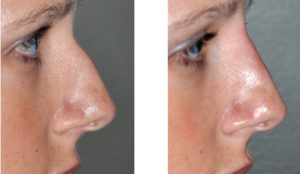
An injectable rhinoplasty can be very successfully done but the question is what filler material is best to do it. With over a dozen filler materials currently available, the most commonly used have been silicone, numerous hyaluronic acid (HA) formulations and calcium hydroxyapatite gel. (CaHA) While all of these have successful histories of general facial soft tissue augmentation, their use in the nose should be approached with a heightened sense of caution.
Silicone (Silikon 1000) is the least commonly used injectable filler and is not FDA-approved for any soft tissue augmentation procedure. But there are more than a handful of practitioners who use it for those patients who seek permanent injectable filler results. While there is no question that silicone injections can work, they are also known to cause significant granulomatous reactions which can be difficult to treat and impossible to ever completely remove the material from the tissues. While silicone filler advocates point to injector technique as the cause of any problems with its use, it is best avoided in the nose.
Calcium hydroxyapatite gel (CaHA, Radiesse) is a thicker more viscous material due to its microspherical content. It is not associated with any significant granulomatous reactions and can safely be put into the nose. But it requires a bigger needle to insert and this can be more uncomfortable to the patient. (not that any nasal injection is pain-free) But its long-lasting effects may justify that trade-off if one has a compassionate injector.
Any of the hyaluronic-acid (HA) fillers offer the easiest and smoothest injection into the thinner tissues of the nose due their smooth linear flow capabililties. Even long lasting HA fillers inject fairly easily. They probably offer the least risk of adverse tissue reactions due to their hyaluron composition and push on the tissues, but this is certainly volume dependent. Many of the HA fillers today have the local anesthetic lidocaine in them, which will not really helping with reducing injection discomfort on the first pass, can make subsequent injections more comfortable and will eliminate any early postinjection discomfort.
While different injectable fillers can be used safely in the nose, how and where they are placed is critical to minimize complications. The injection should be placed deep (sub-SMAS) to eliminate visible lumping of the material. The safest nose areas to inject are the dorsum/radix and bony side walls where the tissues are more elastic and have a resplendid blood supply. Larger volumes of fillers can be easily placed here. While injections can be done in the tip and nostril area, this is where the most complications are seen including tissue necrosis. Very judicious small amount of fillers should be used in these areas if one must do so.
While the injectable and non-surgical rhinoplasty is ‘easy’ to do and offers a quick fix for select nasal problems, it is not complication-free. (nor is it permanent) Caution should be used when injecting into the nose including the choice of filler and the injection location. Injectable fillers work well for camouflaging small to moderate dorsal humps, to correct nasal bones that have been collapsed or have asymmetry and ‘top off’ a rhinoplasty where there remains a slight residual hump.
Dr. Barry Eppley
Indianapolis, Indiana


